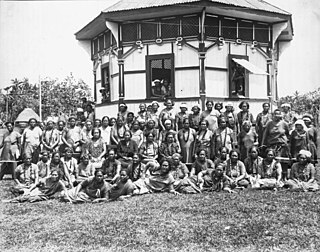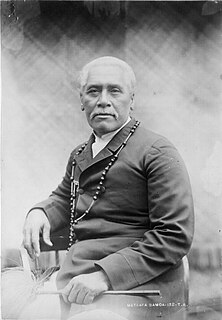
The Mau was a non-violent movement for Samoan independence from colonial rule during the first half of the 20th century. Mau means ‘resolute’ or ‘resolved’ in the sense of ‘opinion’, ‘unwavering’, ‘to be decided’, or ‘testimony’; also denoting ‘firm strength’ in Samoan. The motto for the Mau were the words Samoa mo Samoa. Similarly in Hawaii'an Mau means to strive or persevere, and is often linked with Hawaii'an poetry relating to independence and sovereignty struggles.

Fiame Naomi Mata'afa is a Samoan high chieftess (matai) and the Deputy Prime Minister of Samoa. She is a Member of Parliament (HRPP) for the electoral constituency of Lotofaga in the political district of Atua. She is the current Minister of Women, Community & Social Development in Samoa. Following the March 2006 general elections in which she was reelected for a sixth term she was nominated by Samoan Prime Minister Tuilaepa Sailele Malielegaoi to her new portfolio at her request. She was Minister of Education for 15 years. She is one of the longest standing Members of Parliament in Samoa and the first female member of Cabinet.
Le Mamea Matatumua Ata, OBE, was one of the framers of the Constitution of Samoa. He held senior positions under the New Zealand Trusteeship of Samoa and in the Independent State of Samoa.

Fiame Mata'afa Faumuina Mulinu'u II was a Western Samoan paramount chief and politician. The holder of the Mata'afa title, one of the four main Samoan chieftainships, he became the first Prime Minister of Western Samoa in 1959, serving until 1970. He held the position again from 1973 until his death in 1975.
Masiofo La'ulu Fetauimalemau Mata'afa, also known as Fetaui Mata'afa, was an ambassador and a member of parliament in Samoa. She was also the wife of Samoa's first Prime Minister, Fiame Mata'afa Faumuina Mulinu'u II. Their daughter, Fiame Naomi Mata'afa, is a matai high chief and Cabinet Minister in the Government of Samoa. The honorific title "Masiofo" is the queenly title for the wife of a paramount chief in Samoa.

Samoa is made up of eleven itūmālō. These are the traditional eleven districts that were established well before European arrival. Each district has its own constitutional foundation (faavae) based on the traditional order of title precedence found in each district's faalupega.
Matatumua Maimoana (1935–2012), also known as Matatumua Maimoaga Vermeulen, was a matai, Stateswoman, Nurse and Environmentalist of Samoa. Her chief title, Matatumua, was an orator's title from the village of Faleasiu. She was a former member of parliament in Samoa and the founder of the Samoa All People's Party (SAPP), becoming the first woman to lead a political party in the country. SAPP allowed people as young as 16, regardless of gender or whether they were matai to be officers in the organisation which included village branches. She was a founding member of the Human Rights Protection Party (HRPP), which has dominated Samoan politics in the last two decades.

Susuga Malietoa Laupepa was the ruler (Malietoa) of Samoa in the late 19th century.

Susuga Malietoa Tanumafili I was the Malietoa in Samoa from 1898 until his death in 1939.

Falefā is a large village located on the north east coast of Upolu island in Samoa. It was the ancient capital of Samoa during the time of Tupu Tafa'ifa (King) Fonoti who, after having defeated his siblings Va'afusuaga and Samalaulu for control of Samoa, chose to rule from his new seat in Falefa. It is part of the electoral constituency Anoama'a i Sasa'e, which has produced three Prime Ministers and one Head of State since independence.

Lotofaga is a village on the south coast of Upolu island in Samoa. Lotofaga is also the name of the larger Lotofaga Electoral Constituency which includes Lotofaga village and two other villages, Vavau and Matatufu.

Fa'amatai is the chiefly system of Samoa, central to the organization of Samoan society. It is the traditional indigenous form of governance in the Samoa Islands, comprising American Samoa and the Independent State of Samoa. The term comprises the prefix fa'a and the word matai.

Mata'afa Iosefo was a Paramount Chief of Samoa who was one of the three rival candidates for the kingship of Samoa during colonialism. He was also referred to as Tupua Malietoa To'oa Mata'afa Iosefo.

Mata'afa Faumuina Fiame Mulinu'u I was a high chief of Samoa and a leader of the country's pro-independence Mau movement during the early 1900s. He was the holder of high-ranking ali'i chiefly titles, Mata'afa, Fiame from Lotofaga and Faumuina from Lepea.

Mata'afa is a high chief title in Samoa under the country's Matai system of socio-political governance where individuals are bestowed with family names. The historical seat of the Mata'afa title is in Amaile in the Atua district at the east end of Upolu island.

General elections were held in Western Samoa on 4 April 1964, the first since independence in 1962. All candidates ran as independents. Following the elections, Fiame Mata'afa Faumuina Mulinu'u II remained Prime Minister.

General elections were held in Western Samoa on 25 February 1967. All candidates ran as independents and voting was restricted to Matai and citizens of European origin, with the Matai electing 45 MPs and Europeans two. Following the election, Fiame Mata'afa Faumuina Mulinu'u II remained Prime Minister.

General elections were held in Western Samoa on 28 April 1948, the first to the new Legislative Assembly. The United Citizens Party won four of the five directly-elected seats.

General elections were held in Western Samoa on 15 November 1957.
Anapu Solofa was a Western Samoan chief and politician. He served as a member of the Legislative Assembly and as Minister of Justice.














